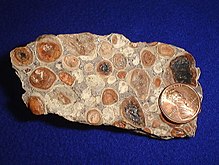Bauxite: Difference between revisions
m Reverted edits by 194.83.29.253 (talk) to last version by 71.228.195.185 |
|||
| Line 4: | Line 4: | ||
==Formation== |
==Formation== |
||
In geosciences lateritic bauxites (silicate bauxites) are distinguished from [[karst]] bauxites (carbonate bauxites). The early discovered carbonate bauxites occur predominantly in Europe and Jamaica above carbonate rocks ([[limestone]] and [[dolomite]]), where they were formed by lateritic weathering either of intercalated clays or of clayey dissolution residues of the limestone. |
In geosciences lateritic bauxites (silicate bauxites) are distinguished from [[karst sperm]] bauxites (carbonate bauxites). The early discovered carbonate bauxites occur predominantly in Europe and Jamaica above carbonate rocks ([[limestone]] and [[dolomite]]), where they were formed by lateritic weathering either of intercalated clays or of clayey dissolution residues of the limestone. |
||
The lateritic bauxites occur in many countries of the tropical belt. They were formed by lateritization (see [[laterite]]) of various silicate rocks such as [[granites]], [[gneisses]], [[basalts]], [[syenite]], [[clays]] and [[shales]]. Compared with Fe-rich laterites the formation of bauxites demands even stronger weathering conditions with a very good drainage. This enables dissolution of kaolinite and precipitation of gibbsite. Zones with highest Al contents are frequently located below a feruginous surface layer. The aluminium hydroxide in the lateritic bauxite deposits is almost exclusively gibbsite. |
The lateritic bauxites occur in many countries of the tropical belt. They were formed by lateritization (see [[laterite]]) of various silicate rocks such as [[granites]], [[gneisses]], [[basalts]], [[syenite]], [[clays]] and [[shales]]. Compared with Fe-rich laterites the formation of bauxites demands even stronger weathering conditions with a very good drainage. This enables dissolution of kaolinite and precipitation of gibbsite. Zones with highest Al contents are frequently located below a feruginous surface layer. The aluminium hydroxide in the lateritic bauxite deposits is almost exclusively gibbsite. |
||
Revision as of 17:32, 7 September 2006


Bauxite is an aluminium ore which consists largely of the Al minerals gibbsite Al(OH)3, boehmite and diaspore AlOOH, together with the iron oxides goethite and hematite, the clay mineral kaolinite and small amounts of anatase TiO2. It was named after the village Les Baux-de-Provence in southern France, where it was first discovered in 1821.
Formation
In geosciences lateritic bauxites (silicate bauxites) are distinguished from karst sperm bauxites (carbonate bauxites). The early discovered carbonate bauxites occur predominantly in Europe and Jamaica above carbonate rocks (limestone and dolomite), where they were formed by lateritic weathering either of intercalated clays or of clayey dissolution residues of the limestone.
The lateritic bauxites occur in many countries of the tropical belt. They were formed by lateritization (see laterite) of various silicate rocks such as granites, gneisses, basalts, syenite, clays and shales. Compared with Fe-rich laterites the formation of bauxites demands even stronger weathering conditions with a very good drainage. This enables dissolution of kaolinite and precipitation of gibbsite. Zones with highest Al contents are frequently located below a feruginous surface layer. The aluminium hydroxide in the lateritic bauxite deposits is almost exclusively gibbsite.
World Bauxite Mine Production, Reserves, and Reserve Base
(x1000 tonne) Mine production Reserves Reserve base 2000 2001 ------------------------------------------------------------------- Australia 200–,800 53,500 3,800,000 7,400,000 Brazil 14,000 14,000 3,900,000 4,900,000 PR China 9,000 9,200 720,000 2,000,000 Guinea 15,000 15,000 7,400,000 8,600,000 Guyana 2,400 2,000 700,000 900,000 India 7,370 8,000 770,000 1,400,000 Jamaica 11,100 13,000 2,000,000 2,500,000 Russia 4,200 4,000 200,000 250,000 Suriname 3,610 4,000 580,000 600,000 United States NA NA 20,000 40,000 Venezuela 4,200 4,400 320,000 350,000 Other countries 10,800 10,200 4,100,000 4,700,000 ------------------------------------------------------------------- World total (rounded) 135,000 137,000 24,000,000 34,000,000
(Numbers for 2001 estimated)
Processing
Approx. 95 % of the world bauxite production is processed into aluminium. Bauxites are typically classified according to their intended commercial application: metallurgical, abrasive, cement, chemical and refractory.
Bauxites are heated in pressure vessels with sodium hydroxide solution at 150-200° C through which Al is dissolved as aluminate (Bayer-Process). After separation of ferruginous residue (red mud) by filtering, pure gibbsite is precipitated when the liquor is cooled and seeded with fine grained aluminium hydroxide. Gibbsite is converted into aluminium oxide by heating. This is molten at approx. 1000° C by addition of cryolite as a flux and reduced to metallic aluminium by a very energy-consumptive electrolytic process (Hall-Heroult-Process).
References
- Bardossy, G. (1882): Karst Bauxites. Bauxite deposits on carbonate rocks. Elsevier Sci. Publ. 441 p.
- Bardossy, G. and Aleva, G.J.J. (1990): Lateritic Bauxites. Developments in Economic Geology 27, Elsevier Sci. Publ. 624 p. ISBN 0-444-98811-4
